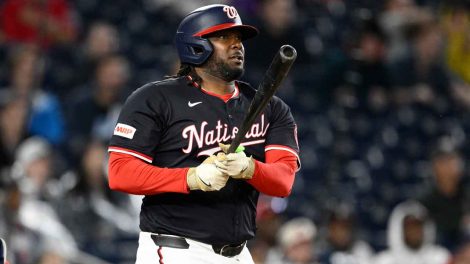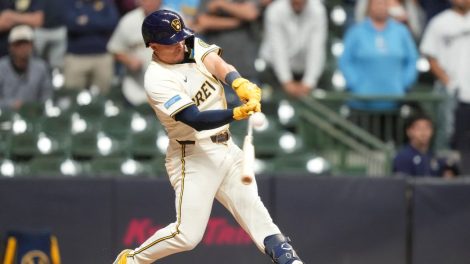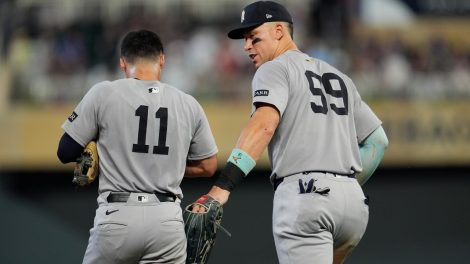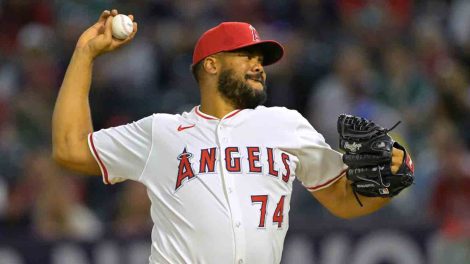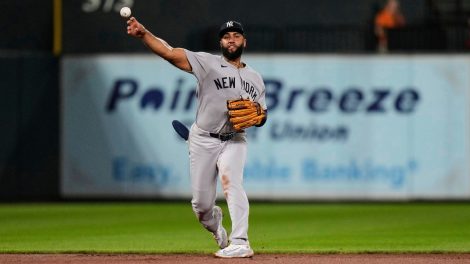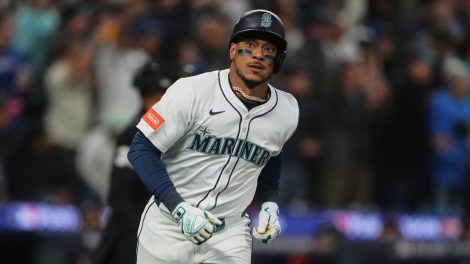The following is Part 2 of Sportsnet’s Q&A with Toronto Blue Jays president and CEO Mark Shapiro. Read Part 1 here.
TORONTO – There will be no major teardown and there will be no massive buildup for the Toronto Blue Jays during the off-season. Instead, they will try to tweak a roster that, at 30.9, had the oldest average age for position players in the majors, and that heading into Friday’s series opener against the New York Yankees had 25 players over 31 disabled list stints lose 1,357 games to injury.
That’s why during an interview with Jeff Blair and Stephen Brunt on Sportsnet The Fan 590 this week, team president and CEO Mark Shapiro intriguingly said "it’s going to be a similar story next year," in terms of the risk and the wide range of possible outcomes.
Shapiro sat down with sportsnet.ca this week, and during a 30-minute conversation in his Rogers Centre office, touched on, well, just about everything.
Sportsnet: On the minor-league side, you’ll have more prospects at triple-A next year than this one. How does that influence your depth shopping this off-season? Do you view guys like Ryan Borucki, Danny Jansen as answers for next year if needed?
Mark Shapiro: I think it more impacts how you feel you can withstand injuries if they happen. It’s still a stretch for Borucki and Dan Jansen and Anthony Alford, you’re still saying those guys have to take the next step and continue to progress for them to be legitimate major-league depth guys. But all three of those guys showed signs at higher levels than double-A this year that it’s possible they can be support for us next year. When you throw in with Anthony, Teoscar (Hernandez) and Dalton (Pompey), you say from those three, we should find one or two guys that can help us win in some way, whether it’s at the outset or during the year. That doesn’t feel like it’s too much of a stretch. So we’re getting better. Certainly in the bullpen we’ll have some alternatives. We’re getting better. Where I think the excitement is, is probably A-ball down this year because we have some ceiling players, some players who have a chance to impact the game and impact the way we build a team.
[relatedlinks]
SN: In terms of player-development, there are people who argue that a player who is going to make it is going to make it regardless of the environment they’re in.
MS: That’s old school.
SN: Others believe they can take somebody’s faults and fix them. Where do you stand?
MS: As someone who’s been in the trenches and done that job for seven years, I hope that 95 per cent of the game feels the way you articulated the second (view) because we will with absolute, definitive conviction beat them. You cannot make players. We will not be able to create players from player development. But you can certainly increase the percentages. You can take a player that may have great physical ability but may struggle with how to compartmentalize failure, with selective ability to focus and provide them the tools to better focus, to handle failure, to separate self-esteem from performance, to better cope with the pressures that come with the major-league baseball environment. You can take a player that is an incredibly talented hitter but may have a breakdown in his kinetic chain someplace that continues to cause hamstring injuries and you can find the root cause of that breakdown, strengthen that area of the kinetic chain and ensure that player is able to play and let his talent translate.
Maybe most simply and the biggest opportunity, you can find better ways to coach and apply the wealth of information that this game continues to spinoff on a daily basis in data and feedback on how players perform. From those things that impact a player mentally, physically and fundamentally, we can increase the percentages on the number of players that come through our farm system that actually achieve their potential, which increases the number that make it to the big-leagues. We can’t make players, we can’t take a guy off the street and make him a major-league player, so it still comes back to Steve (Sanders) and Tony (LaCava) and Andrew (Tinnish) doing a great job identifying and acquiring talent. But we can certainly put them into a player-development system that maximizes the potential of that talent.
SN: Understanding there’s never a finished product, now two seasons in, is the player-development department functioning along the lines you would like it to achieve all those impacts you described?
MS: No. Very much a work in progress and very much still making efforts to be respectful and take advantage of the incredible people that are here, and navigate cultural transformation and apply resources that weren’t here in a way that they can actually be utilized, because it’s new, as well as the structure and process. What I’m confident in 100 per cent is that in Gil Kim, we have the leader that both understands how to treat people and cares deeply about players, and that with the support of Ben Cherington and Eric Wedge, any gap that exists in his experience is more than covered with those guys and that we’ll ultimately be that department, without a doubt.
SN: Are there one or two priority areas you’d like to see addressed this off-season?
MS: Probably not that I would articulate publicly. It’s important to prioritize what your areas of focus are because you can’t get everything done right away. I choose to focus on the incredible amount they have accomplished in a short time, and that the culture is one I’m proud of and that the leadership is a group of leaders I’m proud of.
SN: A key piece of player development has been your work toward a new spring facility. Word is you were close to the finish line before Hurricane Irma struck Florida. How are things sitting right now?
MS: With complete candour, I was real nervous when that happened. First, you turn to concern for the community and the people because obviously as you build up these relationships, you build up a lot of important ties to the people in the communities you work in, particularly for us being a northern organization. Once the hurricane passed and it was clear the brunt of the storm spared Pinellas County and Dunedin, I didn’t really have a good feel for the respectful right time to rekindle conversations. Fortunately, Pinellas and Dunedin both were aggressive about reaching out to us in order to emphasize that they want to continue to work to conclusion. And we’ve made material progress with the county, as well as we continue to inch forward with the city. Really appreciative of the efforts made by Pinellas County to put a deal in place and really optimistic that we’re going to be able to make the same strides with the city as well.
SN: What remaining pieces need to fall into place?
MS: It’s the final pieces of negotiation for a complex funding puzzle that combines city, county and state. Once we finish with the city and the county we have to apply for state funding that is earmarked and in place so we should be able to receive that based on the scope of our project. Then it’s moving to design, which is fun, design and drawing. It’s an aggressive timetable to say we can begin at the end of spring training (2018) but I think it’s attainable. Regardless, we can begin at any point in time, it’s not a project like Rogers Centre that is more unknown. You’d have to really start at the end of a season. It’s a project that we can start whenever and just move our operation around.
SN: I’ve heard some talk about a scenario in which you share the Philadelphia Phillies’ facility in Clearwater until Dunedin is ready.
MS: We’ve talked about Clearwater, we’ve talked about Jack Russell Stadium (the old Phillies’ spring site in Clearwater), it’s still upkept and they still play games there. So we can move our operation around and work around the construction being done, regardless of what’s being done when. Ideally our major-league spring training isn’t impacted at all. That would be a priority. Other than that, everything we do is worth going through some inconvenience to end up with a facility sooner rather than later, because it’s a game-changer for us as an organization. Really, it is. I’ve seen that already once, what that can mean culturally, what that can mean objectively from a training and rehabilitation perspective, particularly for northern-based teams that operate in cold weather environments. The real chance to build a lasting imprint. One of the cool things about this one if we get it done is we’re doing that in a very traditional, old-school spring training environment so it’s going to combine the best of the modern with the best of the old-school charm of spring training.
SN: As for your other major capital project, you had hoped to have some plans ready by the season’s end or year’s end for the Rogers Centre renovation. Where do things sit there?
MS: Still hopeful on that. Obviously up here it’s private funding so it’s a matter of where that sits in the organizational priorities for the broader company and having active conversations and hope to get certainty and clarification on that soon.
SN: From what you’ve seen to this point, are there a few things you can share with the fanbase about the dome’s future?
MS: We need to get an idea of where the funding goes first. We’re one of three multipurpose stadiums left in circulation out of 30 major-league baseball teams. The other two are already kind of clearly scheduled to be blown up and have new stadiums built, so we’ll be the only one originally designed as a multipurpose stadium. I would say taking this stadium from a stadium to a ballpark, creating a diversity of options for how fans watch the game – that has to deal with food and beverage, that has to deal with seating alternatives, structures and sightlines, as well as modern amenities throughout the ballpark – some connectivity and openness to the field, to the city, some celebration of history and heritage of the organization, those are more the themes. And right now I’m more comfortable talking about the themes than I am about the execution. Once we have the funding, then we’ll go to, OK, what’s the execution going to look like? Do we have some ideas? Yes, we have ideas now. Are we certain which ones we would move forward on? Not until we’re certain on the levels of funding.

